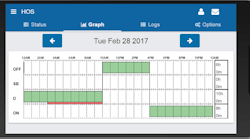The Federal Motor Carrier Safety Administration (FMCSA) is seeking public comment on a pilot program that would create hours of service (HOS) regulatory relief by allowing participating drivers to pause their on-duty driving period with one off-duty period up to three hours.
FMCSA is requesting public input on the Split Duty Period Pilot Program, which would allow drivers one off-duty break of at least 30 minutes, but not more than three hours, that would pause a truck driver’s 14-hour driving window, provided the driver takes 10 consecutive hours off-duty at the end of the work shift. Participation in this pilot program would be limited to a certain number of commercial driver’s license (CDL) holders who meet the criteria specified for participating. This pilot program—scheduled to run for up to three years—would gather “statistically reliable evidence to analyze the safety and feasibility of such a modification to the hours of service rules,” according to the FMCSA.
This proposed pilot program is separate from the new HOS rules that take effect nationwide on Sept. 29. Among the new rules, drivers will be permitted to split up off-duty time thanks to a revised sleeper berth provision. The proposed pilot program, however, gives drivers the option to pause the on-duty clock for 30 min to three hours without using the split-sleeper berth provision, which will require at least a 2-hour break.
Along with the sleeper berth provision changes coming this fall, the FMCSA is loosening restrictions to the short-haul exception, creating more flexibility for drivers who encounter unexpected adverse driving conditions, and a change in what counts toward a driver's mandatory 30-minute break.
“Truckers are American heroes—they keep our supply chain moving; they carry essential goods we need to maintain our daily lives,” said Transportation Secretary Elaine L. Chao in a statement. “The Department is seeking public comments on providing additional flexibility for truckers as they work to serve our country during this public health crisis.”
On Aug. 22, 2019, FMCSA published a Notice of Proposed Rulemaking (NPRM) concerning drivers' hours of service that proposed certain amendments to provide greater flexibility for drivers. As part of that rulemaking, FMCSA proposed that a single off-duty break of between 30 minutes and three consecutive hours may be excluded from the 14-hour driving window, provided the driver has at least 10 consecutive hours off-duty at the end of the work shift.
The agency explained that a single pause of up to three hours would provide “significantly more flexibility than is allowed under the current rules. The pause would have allowed drivers to take an off-duty break without fear of exhausting their available hours under the 14-hour clock, which would also have allowed them to get additional rest or avoid traffic congestion.”
After reviewing the public comments to the NPRM, the FMCSA decided not to include the pause to the 14-hour driving window in the final rule, which was published on June 1. FMCSA continues to believe that an opportunity for a single off-duty pause in the 14-hour driving window could provide flexibility for drivers without compromising safety. However, many commenters to the NPRM believed that drivers would be pressured by carriers, shippers, or receivers to use the break to cover detention time, which would not necessarily provide the driver an optimal environment for restorative rest.
FMCSA stated that it believes a pilot program would provide an “innovative, collaborative approach for evaluating concerns about the use of a pause to the 14-hour window.” Through the pilot program, FMCSA intends to gather data and information concerning real-world actions and decisions among drivers, employers, and shippers and receivers to reach a common understanding of how to give drivers more opportunities for rest and increased efficiency.
FMCSA also noted that the additional break of up to three consecutive hours would be off-duty, meaning the extension of the driving window would not result in drivers working additional hours; the maximum amount of on-duty time that could be accumulated before a driver would be prohibited from driving during a work shift would remain at 14 hours.
“FMCSA wants to hear directly from drivers about the possibility and safety of an hours of service pause pilot program. The agency remains committed to exploring ways to improve safety on our roadways while increasing flexibility for truckers. We encourage drivers, motor carriers, and interested citizens to review the proposed pilot program and provide substantive public comments for FMCSA to review,” said FMCSA Deputy Administrator Jim Mullen.
In May 2020, the Agency published a final rule updating existing HOS regulations to provide greater flexibility, allow drivers more control over their workdays, and reduce regulatory burdens by $273 million annually. The updated HOS rules will go into effect on Sept. 29, 2020.
The pilot program comment period will be open for 60 days. Comments must be received on or before 60 days after publication in the Federal Register. The implementation date of the pilot program will be announced in subsequent Federal Register notices. Review the proposed pilot program here.



